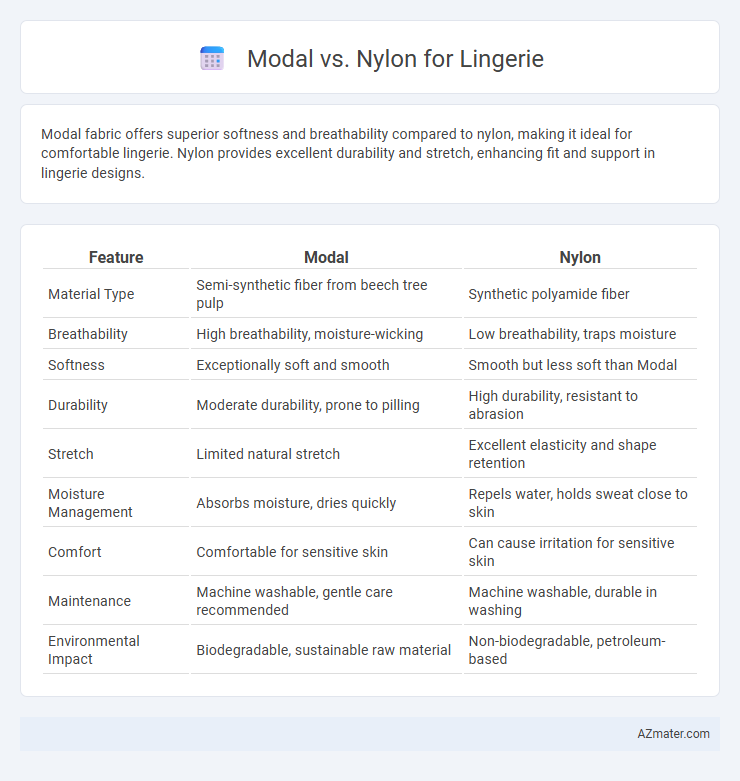Modal fabric offers superior softness and breathability compared to nylon, making it ideal for comfortable lingerie. Nylon provides excellent durability and stretch, enhancing fit and support in lingerie designs.
Table of Comparison
| Feature | Modal | Nylon |
|---|---|---|
| Material Type | Semi-synthetic fiber from beech tree pulp | Synthetic polyamide fiber |
| Breathability | High breathability, moisture-wicking | Low breathability, traps moisture |
| Softness | Exceptionally soft and smooth | Smooth but less soft than Modal |
| Durability | Moderate durability, prone to pilling | High durability, resistant to abrasion |
| Stretch | Limited natural stretch | Excellent elasticity and shape retention |
| Moisture Management | Absorbs moisture, dries quickly | Repels water, holds sweat close to skin |
| Comfort | Comfortable for sensitive skin | Can cause irritation for sensitive skin |
| Maintenance | Machine washable, gentle care recommended | Machine washable, durable in washing |
| Environmental Impact | Biodegradable, sustainable raw material | Non-biodegradable, petroleum-based |
Introduction to Modal and Nylon Fabrics
Modal fabric, a semi-synthetic fiber made from beech tree pulp, is prized for its softness, breathability, and moisture-wicking properties, making it ideal for comfortable and luxurious lingerie. Nylon, a synthetic polymer known for its exceptional strength, elasticity, and durability, offers excellent shape retention and smooth texture, enhancing the fit and support in lingerie designs. Both fabrics cater to different needs in lingerie production, with Modal emphasizing comfort and natural feel, while Nylon prioritizes resilience and form.
Key Differences Between Modal and Nylon
Modal lingerie offers superior breathability and moisture-wicking properties compared to nylon, making it ideal for sensitive skin and all-day comfort. Nylon provides excellent durability, elasticity, and a smooth, glossy finish, often enhancing the structural support and shape retention of lingerie. While Modal is derived from natural fibers promoting eco-friendliness, nylon is synthetic, offering higher resistance to abrasion and quicker drying capabilities.
Comfort: Modal vs Nylon for Lingerie
Modal fabric offers superior softness and breathability compared to nylon, making it ideal for comfortable lingerie that feels gentle against the skin. Nylon, while durable and stretchy, can sometimes trap heat and cause discomfort during prolonged wear. Choosing modal lingerie enhances moisture-wicking and reduces irritation, providing a cooler, more comfortable fit throughout the day.
Breathability and Moisture-Wicking Comparison
Modal fabric offers superior breathability and moisture-wicking properties compared to nylon, making it ideal for lingerie that requires comfort and temperature regulation. Modal fibers are highly absorbent, efficiently drawing sweat away from the skin to maintain dryness throughout the day. In contrast, nylon tends to retain heat and moisture, which can lead to discomfort and reduced ventilation in lingerie applications.
Durability and Longevity of Modal and Nylon Lingerie
Modal lingerie offers superior durability due to its high resistance to shrinking, pilling, and color fading, maintaining softness and shape after multiple washes. Nylon lingerie is highly durable as well, known for its exceptional strength, elasticity, and resistance to abrasion, making it ideal for long-lasting wear. Both fabrics ensure longevity, but Modal's breathable and moisture-wicking properties provide added comfort that enhances the lifespan of lingerie with regular use.
Softness and Feel: Which is Better for Sensitive Skin?
Modal fabric, made from beech tree pulp, offers exceptional softness and breathability, making it highly suitable for sensitive skin due to its smooth, silky texture and moisture-wicking properties. Nylon, although durable and elastic, can sometimes cause irritation or discomfort for those with sensitive skin because it is less breathable and can trap heat and sweat. For lingerie prioritizing softness and skin comfort, modal is generally the better choice because it provides a gentle, lightweight feel that reduces friction and irritation.
Stretch and Fit: Modal vs Nylon Performance
Modal fabric offers superior stretch and recovery in lingerie, providing a comfortable fit that adapts to body contours without losing shape over time. Nylon excels in elasticity and durability, delivering a snug fit with excellent resistance to wear and moisture, making it ideal for activewear lingerie. Both materials balance stretch and support, but Modal prioritizes softness and flexibility, whereas Nylon emphasizes resilience and form retention.
Care and Maintenance: Washing Modal and Nylon Lingerie
Modal lingerie requires gentle washing in cold water using a mild detergent to preserve its softness and prevent shrinkage, and it is best air-dried flat to maintain shape. Nylon lingerie should be hand-washed or placed in a mesh laundry bag for machine washing on a delicate cycle, using cold water and mild detergent, then air-dried to avoid heat damage and fabric degradation. Both fabrics benefit from avoiding bleach and fabric softeners, which can weaken fibers and reduce the longevity of lingerie items.
Eco-Friendliness: Sustainability of Modal vs Nylon
Modal lingerie is significantly more eco-friendly than nylon due to its renewable beech tree origin and biodegradable properties, reducing environmental impact during production and disposal. Nylon, derived from petrochemicals, contributes to plastic pollution and has a higher carbon footprint, making it less sustainable for lingerie manufacturing. Choosing modal supports sustainable fashion by promoting reduced resource consumption and enhanced biodegradability.
Choosing the Right Fabric: Modal or Nylon for Your Lingerie Drawer
Modal lingerie offers superior breathability and moisture-wicking properties, making it ideal for all-day comfort and sensitive skin. Nylon, known for its durability and smooth finish, provides excellent stretch and support, perfect for shaping and form-fitting designs. Selecting between Modal and Nylon depends on prioritizing comfort and natural feel versus strength and elasticity in your lingerie drawer.

Infographic: Modal vs Nylon for Lingerie
 azmater.com
azmater.com